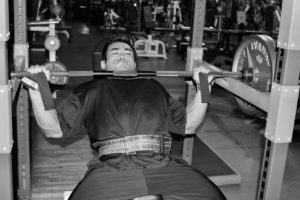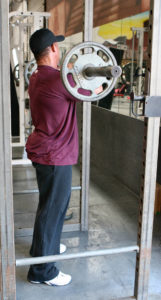The Power Rack Advantage

Using partial range exercises to become brutally strong!
By Strength Sensei CP
Smith machines have become a popular item in commercial gyms, often replacing the traditional power rack. They take up less space than a power rack and are undoubtedly convenient when it comes to set-up, but they take a distant second in value to the power rack. Let me tell you why.
Although many variations exist, a basic power rack contains four vertical posts linked with crossbars for stability. A standard size is 48 x 48 inches square and 84 inches tall. Holes are cut into the posts for two reasons. First, barbell catches can be attached to hold a barbell, and safety bars can be inserted to catch the bar. Besides safety, these bars enable the user to start exercises such as bench presses and deadlifts from a set height.
Many athletes place the barbell catches on the outside of the racks as they feel uncomfortable squatting inside this “cage.” This approach defeats the purpose of having safety bars. Without a spotter on the squat, the weight will drop on the floor, often damaging the floor, the barbell, and (in case of an inexperienced lifter) the person squatting! Weightlifters will squat in open space but on a platform and with bumper plates; in case of a miss, the fall will not damage the barbell.
As for the bench press, the use of safety bars can be a matter of life or death. Seriously! The risk of injury is especially for those who use a grip with the thumbs on the same side as the fingers, which is less secure. Should the bar slip, the weight can drop across the throat, causing catastrophic injury or death. A spotter can help, but often spotters are not well trained or attentive and will not act quickly enough to catch the weight or change its direction away from the throat.
 A basic power rack consists of four vertical posts linked together, barbell catches, and adjustable safety bars. (Miloš Šarčev photos)
A basic power rack consists of four vertical posts linked together, barbell catches, and adjustable safety bars. (Miloš Šarčev photos)
Safety is one advantage of the power rack. Another is to perform partial movements to overload are areas of the strength curve.
Partial movements have many benefits to body bodybuilders and strength athletes. For a powerlifter with a poor lockout in the deadlift, they can adjust the safety bars so the barbell is positioned just above the knees. This limited-range deadlift will enable them to concentrate on their weakness. Here is a deadlift specialization tri-set I’ve used with such athletes with great success:
A1. Deadlift: 5 x 3, 40X1, rest 180 seconds*
A2. Deadlift from Knee Level: 5 x 5, 21X1, rest 120 seconds
A3. Barbell Shoulder Shrugs: 5 x 10, 1011, rest 90 seconds
*Note that as the range of motion decreases, the reps increase. This is to keep the time under tension (TUT) at a consistent level. I am not a fan of using a wide range of TUT for most workouts as the body doesn’t know what it’s supposed to adapt to. Better to focus on one TUT range for a specific training phase, such as two weeks, and then move to another one. My basic workout format alternates between an accumulation phase (overloading by intensity) and an intensification phase (overloading by volume).
For the bench press, one of my favorite exercises to help with a poor lockout is the close-grip bench press. Often a poor lockout is due to relatively weak triceps, and a close-grip on the bench press targets this muscle group more than the conventional exercise. Also, because the highest recruitment of these muscles occurs at the end range of the bench press, you want to limit the range of motion of the exercise. Here’s how to do it.
Place the safety bar so that the bar rests several inches above your chest so that it is only about one-third or less of what it usually is. Pause at the bottom of the movement, where the bar stops, so that you cannot use the elastic components of the muscle (Note: a four-second pause will eliminate most of this elastic effect). As with the deadlift, use TUT, not just reps, to determine the training effect.
To learn more about performing partial training in the power rack, I highly recommend Developing Physical Strength by Anthony Ditillo. When I’m asked which book I would rescue from a burning house, that’s the one. I especially recommend this book for bodybuilders who want to be as strong as they look, or as I like to call them, power bodybuilders.
The power rack was a must in old-school gyms, and you should seek out gyms that have these to take your strength to the higher levels. (SS)
